Unmasking Skitnet: The Emerging Malware Threat in Cybersecurity
A deep dive into the sophisticated tactics and implications of Skitnet for security professionals.
In the fast-paced and ever-evolving realm of cybersecurity, staying one step ahead of emerging threats is crucial. One such threat that has swiftly garnered attention is Skitnet. This sophisticated malware, also known as Bossnet, burst onto the scene in April 2024 and has left cybersecurity professionals racing to understand its complexities. In this article, we will explore Skitnet’s operational intricacies, its advanced evasion techniques, and strategies to mitigate its risks.
What is Skitnet?
So, what exactly is Skitnet? This crafty malware operates as a multi-stage package, traded on underground forums, and deploys an arsenal of threat capabilities that blend innovation with stealth. Notably, Skitnet is engineered using a combination of programming languages like Rust, Nim, .NET, and PowerShell, allowing it to evade traditional detection systems while maximizing its operational efficiency.
Key Attributes of Skitnet
When dissecting Skitnet, several key features stand out:
Multi-Language Architecture: Its use of various programming languages not only enhances its flexibility but also aids in avoiding detection from legacy systems.
Automated Installation via Bash Scripts: Skitnet minimizes human involvement with automated scripts for installation, allowing for rapid deployment across targeted systems.
Encrypted Payloads: Utilizing ChaCha20 encryption to conceal its payload, Skitnet is difficult to detect under conventional security checks.
Dynamic DNS Communication: It employs unique DNS resolution techniques, ensuring its command and control channels evade common firewall defenses.
Advanced Evasion Techniques
Understanding how Skitnet evades detection is fundamental in combating its effects. Recent analyses reveal several advanced tactics:
Evasion Tactics
Manual Mapping in Memory: A key feature is its ability to decrypt its payload and map it into memory, thereby sidestepping traditional disk monitoring tools. This tactic is notably evident in operations utilizing DInvoke-rs for stealth execution.
Dynamic Function Resolution: Skitnet cleverly uses
GetProcAddressto dynamically resolve API functions, which helps to bypass static analysis often used in malware detection.
Persistence Mechanisms
To ensure longevity within compromised systems, Skitnet deploys sophisticated persistence techniques:
DLL Hijacking: This method exploits legitimate software by inserting malicious DLLs to manipulate application execution flows.
Scheduled Tasks and Startup Scripts: By creating persistent entries in Windows Startup folders or using scheduled tasks, Skitnet guarantees re-execution, masking its operations in familiar system behaviors.
Post-Exploitation Instrumentation
Once inside a system, Skitnet doesn’t just linger—it thrives. Some of the alarming post-exploitation capabilities include:
Screen Capture and Keylogging: These tools enable deep surveillance and data exfiltration.
Deployment of Remote Access Tools: Skitnet can install legitimate remote tools like AnyDesk, embedding itself further into the network to facilitate deeper infiltration.
Data Exfiltration: Employing encrypted channels, it efficiently siphons sensitive information from compromised systems.
Spotlight on Recent Research
Recent findings have spotlighted the growing use of Skitnet in targeted Ransomware-as-a-Service (RaaS) operations. Notable instances include:
Affiliation with Ransomware Groups: In early 2025, Black Basta affiliates reportedly utilized Skitnet in Teams-themed phishing campaigns, indicating its versatile application in the cybercrime ecosystem.
Reconnaissance and Lateral Movement: Analyses from cybersecurity experts like PRODAFT highlight how Skitnet aids in reconnaissance, data theft, and lateral movement within corporate infrastructures, marking a decisive shift towards stealth-centric attack strategies.
Strengthening Defenses: Current Mitigation Strategies
In light of Skitnet’s sophisticated nature, organizations must bolster their defenses with the following strategies:
Behavioral Analysis: Shift your focus away from traditional signature-based detection to behavioral and heuristic analysis that identifies unusual activities associated with Skitnet.
Endpoint Detection and Response (EDR): Implement EDR solutions for real-time monitoring and automated responses to unauthorized actions and alterations.
User Awareness Training: Educate employees about social engineering risks and proper email protocols to reduce initial attack vectors.
Regular Software Updates: Maintain up-to-date systems and applications—regular audits are key to cutting down available vulnerabilities for Skitnet to exploit.
Conclusion
Skitnet signals a significant evolution in malware sophistication, merging multiple programming languages, advanced stealth techniques, and complex execution strategies. As Skitnet and similar threats proliferate, the necessity for robust, proactive, and informed cybersecurity measures becomes more pressing than ever. This case exemplifies the importance of continuous learning and adaptation, stressing that cybersecurity professionals must not only react but also anticipate the evolving threat landscape.
It's crucial for cybersecurity teams to collaborate and exchange insights regarding these emerging threats to strengthen our collective defenses against sophisticated malware like Skitnet. Join the conversation below—share your thoughts, experiences, or insights regarding Skitnet and its impact on cybersecurity. Let’s work together to build a safer digital world!











Share this post